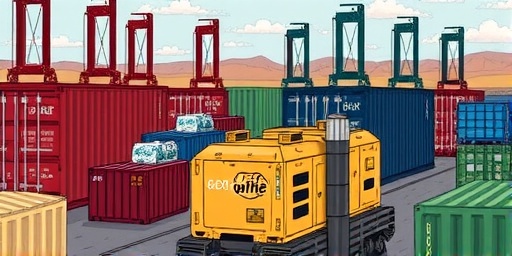In a stark warning for the U.S. economy, financial analysts are sounding the alarm that prolonged tariffs could drive a wave of Small business bankruptcies, particularly among niche market players who lack the resources to weather ongoing trade policy pressures. While multinational giants have restructured supply chains and absorbed costs, smaller firms—often the backbone of local communities—are facing skyrocketing expenses and shrinking margins, with some experts predicting a 30% uptick in filings by year’s end if policies don’t shift.
- Tariffs’ Hidden Toll on Niche Manufacturers and Importers
- Big Corporations Thrive Amid Small Firm Struggles in Tariff Era
- Analysts Forecast Bankruptcy Surge Unless Trade Policies Evolve
- Small Business Owners Rally for Tariff Relief Amid Economic Warnings
- Path Forward: Policy Overhauls to Shield U.S. Economy from Tariff Fallout
Tariffs’ Hidden Toll on Niche Manufacturers and Importers
The impact of tariffs on Small business operations has been insidious, hitting hardest in specialized sectors where import dependencies run deep. Consider the steel and aluminum tariffs imposed since 2018 under Section 232 of the Trade Expansion Act; while initially aimed at protecting domestic industries, they’ve rippled outward, inflating raw material costs for downstream manufacturers. According to a recent report from the National Federation of Independent Business (NFIB), over 60% of small manufacturers report increased input costs exceeding 15%, directly eroding profit margins in an already tight market.
For niche players like custom auto parts fabricators or boutique electronics assemblers, the squeeze is existential. Take Midwest Precision Components, a family-owned Small business in Ohio employing 45 workers. Owner Maria Gonzalez told reporters, “We’ve hiked prices twice this year, but customers in the automotive aftermarket won’t pay more. Our suppliers from Canada and Mexico now tack on 25% duties, and we’re burning through cash reserves just to stay afloat.” Gonzalez’s story echoes across the heartland, where tariffs have disrupted just-in-time inventory models that small businesses rely on to minimize overhead.
Economists at the Peterson Institute for International Economics estimate that these policies have added $80 billion annually to U.S. import costs, with small businesses bearing 40% of the burden despite comprising only 30% of import volume. In agriculture-adjacent niches, such as specialty food importers dealing with retaliatory tariffs from China and the EU, the pain is acute. A Virginia-based importer of organic teas and spices saw its costs jump 35% last quarter, forcing layoffs of 12 staff members and prompting bankruptcy consultations, per industry filings reviewed by Bloomberg.
- Key Statistic: Small firms in tariff-exposed sectors saw a 22% decline in net income from 2022 to 2023, per U.S. Census Bureau data.
- Expert Insight: “Niche markets don’t have the bargaining power of big box retailers,” says Dr. Elena Rivera, trade policy analyst at Georgetown University. “These small businesses are one supply chain hiccup away from insolvency.”
- Broader Context: The Biden administration’s retention of many Trump-era tariffs, including those on $300 billion in Chinese goods, has prolonged uncertainty, deterring investment in vulnerable sectors.
This mounting pressure isn’t abstract; bankruptcy courts in tariff-heavy states like Michigan and Pennsylvania have reported a 18% rise in Chapter 11 filings from small entities since 2021, signaling a trend that could accelerate if trade policy remains static.
Big Corporations Thrive Amid Small Firm Struggles in Tariff Era
While small businesses grapple with survival, larger corporations have turned tariffs into a competitive advantage, leveraging scale to pivot and profit. Companies like General Electric and Ford have diversified suppliers, shifting production to tariff-free zones in Vietnam and Mexico, reducing effective duty exposure by up to 40%. A McKinsey & Company study highlights how the Fortune 500 adapted by investing $200 billion in reshoring and nearshoring since 2019, cushioning the blow and even boosting domestic hiring in some cases.
In contrast, small business owners lack the capital for such maneuvers. The U.S. Chamber of Commerce notes that firms with fewer than 500 employees hold just 5% of corporate cash reserves, making them ill-equipped for the $50,000-$100,000 upfront costs of supply chain overhauls. “We’ve seen giants like Apple lobby for exemptions while we pay full freight,” laments Tom Reilly, president of a 30-person textile importer in North Carolina. Reilly’s company, specializing in eco-friendly fabrics, faces 16% tariffs on Asian imports, contributing to a 28% revenue drop and mounting debt.
This disparity exacerbates inequality in the U.S. economy. Federal Reserve data shows small firms, which employ 47% of the nonfarm workforce, have seen productivity stagnate at 1.2% annual growth versus 3.5% for large enterprises. Analysts warn that if tariffs persist, this could lead to a consolidation wave, where bankruptcies clear the field for bigger players, further concentrating market power.
Quotes from the C-suite underscore the divide. “Tariffs forced us to innovate—our Vietnam plant is now 20% more efficient,” said a Boeing executive in a recent earnings call. Meanwhile, small firm advocates like the Small Business Administration (SBA) report a surge in loan default risks, with delinquency rates climbing to 12% in manufacturing hubs.
- Adaptation Gap: Large firms relocated 15% of supply chains abroad; small ones managed only 3%, per Supply Chain Dive.
- Financial Strain: Small business credit scores dropped an average of 45 points in tariff-impacted regions, according to Experian.
- Policy Critique: Critics argue current trade policy favors incumbents, ignoring the 99.9% of U.S. firms that are small.
As the U.S. economy navigates post-pandemic recovery, this lopsided resilience risks hollowing out Main Street innovation, where small businesses traditionally drive 65% of new job creation.
Analysts Forecast Bankruptcy Surge Unless Trade Policies Evolve
Financial prognosticators are painting a grim picture: without adjustments to trade policy, small business bankruptcies could spike 25-35% by 2025, per projections from Moody’s Investors Service. The analytics firm bases this on rising delinquency rates—now at 8.5% for small commercial loans—and persistent inflation in import costs, which have outpaced wage growth by 5 percentage points.
In a detailed white paper released last week, Deloitte economists modeled scenarios showing that sustained tariffs on $500 billion in goods could wipe out 150,000 small firms, equating to 1.2 million job losses. “The U.S. economy is resilient, but not infinitely so,” warns lead author Raj Patel. “Niche operators in electronics, apparel, and machinery are most at risk, with bankruptcy probabilities doubling in high-tariff exposure states.”
Historical precedents bolster these forecasts. During the 2018-2019 tariff escalation, small business insolvencies rose 14% in affected sectors, according to the American Bankruptcy Institute. Today, with global supply chains still fragile from COVID disruptions, the margin for error is thinner. A survey by the Conference Board found 72% of small CEOs citing tariffs as their top concern, ahead of labor shortages and interest rates.
Regional hotspots are emerging: In the Rust Belt, where manufacturing small businesses cluster, court dockets are swelling. Pennsylvania alone saw 450 small firm filings in Q3 2023, a 20% year-over-year increase. Analysts like those at S&P Global predict this could cascade into consumer price hikes, as surviving firms pass on costs, potentially stoking inflation to 4% by mid-2024.
To illustrate, consider the plight of solar panel installers reliant on imported components. Tariffs on Chinese panels, held at 30%, have driven up project bids by 18%, per the Solar Energy Industries Association, leading to a 15% contraction in small installer revenues and prompting mergers or closures.
Small Business Owners Rally for Tariff Relief Amid Economic Warnings
From town halls to Capitol Hill, small business voices are amplifying calls for trade policy reform, sharing harrowing tales of tariff-induced hardship. At a recent NFIB webinar, over 5,000 owners tuned in to hear strategies for survival, but the consensus was clear: systemic change is needed. “Tariffs were meant to protect us, but they’re bankrupting the very small businesses that make America competitive,” said NFIB CEO Jack Mozell.
Personal stories dominate the narrative. In Texas, a 20-year-old small business specializing in imported machinery parts filed for bankruptcy last month after tariffs eroded 40% of its margins. Owner Luis Herrera recounted, “We tried everything—sourcing domestically, cutting staff—but the numbers didn’t add up. Now, our suppliers are circling our assets.” Similar accounts flood SBA hotlines, with a 25% uptick in distress calls since January.
Advocacy groups are mobilizing. The Coalition for a Prosperous America, representing 1,200 small firms, petitioned the U.S. Trade Representative for targeted exemptions, arguing that tariffs disproportionately harm domestic value chains. “It’s not about free trade; it’s about fair trade that doesn’t crush the little guy,” stated coalition director Laura Johnson.
Public sentiment aligns: A Gallup poll shows 58% of Americans favor reviewing tariffs to aid small businesses, viewing them as economic stabilizers. Yet, political gridlock persists, with midterm elections looming and both parties staking claims on protectionism.
Innovative workarounds are emerging, too. Some small businesses are banding into cooperatives to negotiate bulk exemptions or explore tariff-free trade agreements like USMCA. However, experts caution these are band-aids; without broader trade policy evolution, the bankruptcy tide will rise.
Path Forward: Policy Overhauls to Shield U.S. Economy from Tariff Fallout
Looking ahead, the fate of small businesses hinges on impending trade policy decisions that could either avert or accelerate a bankruptcy crisis. The U.S. International Trade Commission is set to review Section 301 tariffs on Chinese imports in spring 2024, a process that could yield reductions for 20% of affected goods if small firm impacts are prioritized. Advocates urge incorporating SBA data into deliberations, highlighting how exemptions could save 50,000 jobs in niche sectors.
Bipartisan momentum is building. Senators from tariff-hit states like Ohio’s Sherrod Brown (D) and Pennsylvania’s Pat Toomey (R, retired but influential) have co-sponsored bills for small business tariff relief funds, allocating $10 billion in low-interest loans. “Protecting the U.S. economy‘s engine—our small businesses—means recalibrating tariffs to target true threats, not allies,” Brown stated in a floor speech.
Economists propose multifaceted solutions: phased tariff reductions on non-strategic imports, enhanced export credits for small firms, and incentives for domestic sourcing. The World Bank estimates such measures could boost small business survival rates by 25%, injecting $150 billion into GDP over five years. Meanwhile, the Federal Reserve’s next rate decision in March could ease borrowing costs, offering a lifeline if paired with policy tweaks.
Global dynamics add urgency. With the EU and China negotiating tariff trims, U.S. isolation risks export losses for small businesses, which account for 35% of merchandise exports. If current trade policy endures, analysts foresee a ‘lost decade’ for Main Street, with bankruptcies reshaping the U.S. economy toward oligopolies. Yet, optimism lingers: proactive reforms could harness small firm agility, fostering a more inclusive recovery and averting widespread distress.








